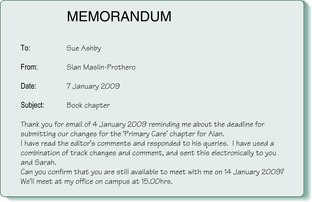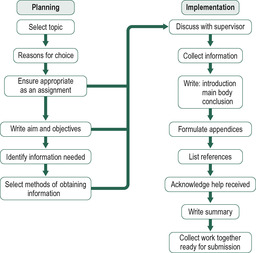Introduction
The aim of this chapter is to assist you in preparing and presenting material either for oral or written presentations. The first part of the chapter looks at different styles of writing and the remainder looks at the presentation of written material. This will provide you with a framework, which you can adapt to meet your requirements.
Being asked to write something – be it an essay, a report or an article – can be a daunting task. If you are undertaking any course of study, completing a written assignment is still the most common form of assessing student learning. How to write an essay is covered in Chapter 6 and Chapter 8; this chapter examines other ways of presenting written material.
You will already have considerable experience of writing and presenting material for others; for example, completing assignments as part of coursework in school or college or, in practice areas, writing care plans and reports to colleagues in handover or ward rounds. This allows you to link theory with practice. In each of these scenarios, you have to identify what is the most important information; that is, what needs to be communicated and what is not essential. You then provide the essential information in the most appropriate format and style. This will be different according to whether you are providing a presentation (to an audience) or a written piece of work.
Different styles of writing
In Chapter 6, you looked at writing skills and developing an argument. There will be other forms of writing that you will need to do as part of your course or as a daily activity. These will include some of the following:
Each one of the above has special features that need to be considered prior to preparation and before actually writing.


• What is the material for?
• Who is going to read it?
• How long should it be?
• Should it be written in the first or third person?
Writing for different purposes
The style and content you adopt for writing will vary depending on the task. A letter to a member of your family or to a friend is likely to be very different from a memo sent to a colleague. A memo or memorandum is a communication used in businesses; they are more informal than letters, and do not require a signature or closing statement. They are usually written as a reminder or to present some basic information. A memo format is generally short, consisting of between one and four sentences (Figure 9.1).
 Tips for writing a memo
Tips for writing a memo
• How much information do you need to convey?
• Who do you need to communicate with?
• Include:
○ times, dates and places to meet
○ reminders
○ new basic information
○ requests for confirmation, information or feedback
 |
| FIGURE 9.1 |
How to prepare a project
You are likely to have to undertake a project as part of a course or in your work environment. This can seem a frightening prospect, although it can also be a satisfying experience. The key to success is preparation; this involves developing a plan. Before embarking on this, you need to consider the following questions.
 What have I got to do?
What have I got to do?
 What have I got to do?
What have I got to do?Use the assignment guidelines to help you decide:
 How much time do I have to complete the project?
How much time do I have to complete the project?
■ the subject
■ the word limit
■ the date for submission.
 How much time do I have to complete the project?
How much time do I have to complete the project?Be realistic. You need to structure and plan your time. Remember to include some extra time to allow for events such as lost data or computer breakdown. Once you have drawn up a timetable, try to stick to it.
Drawing on Chapter 1, which discussed planning and organizing your time, completing a project is similar to writing an essay (see Chapter 6 and Chapter 8). The flow diagram shown in Figure 9.2 can help you organize your work effectively. Your aims and objectives (see Chapter 1 for definition) will be the basis for deciding what information you require to complete the project.
 Do use headings and sub-headings to help guide the reader.
Do use headings and sub-headings to help guide the reader.
 Do use headings and sub-headings to help guide the reader.
Do use headings and sub-headings to help guide the reader. |
| FIGURE 9.2 |
How to prepare a report
The structure of a report is different from an essay or a letter. Reports are written because there is a need for specific information; for instance, where a problem has been identified and requires investigation. Reports are written for a purpose and target a specific audience. They are statements presented in a logical sequence leading to conclusions and possible recommendations for future action. A good report is characterized by its objectivity and systematic presentation. Reports have a format that leads the reader quickly to the main themes and findings.
Content of a report
All information contained in the report must be relevant, concise and substantiated, and it must be presented in a clear, logical sequence. The report should have an introduction in which the terms of reference are defined. The terms of reference include: who has commissioned the report; why they have asked for the report to be written; the purpose of the report; who the report is for; and who is going to read the final report. Essential background material may be included, or you can put details in the appendices. Some or all of the following may be included in the report. The method is where you tell the reader how you went about obtaining the information or analysed the information for the report. The results are where you present your findings. The discussion is where you discuss the implications of your findings. The summary is where you summarize the results. The recommendations are based on your findings.
The writing style should be clear and specific. Aim to use short and simple sentences, so that the reader easily understands the report. The report should be coherent and non-anecdotal. All sections, sub-sections and points must have headings and must be numbered and indented. This is so that the report flows logically and information can be easily retrieved. The box below illustrates the layout of a report.
Abstract
1 Introduction
1.1 Style
1.1.1 Ensure that the writing style, language and level are appropriate forthe intended audience.
1.2 Report writing is formal; reports are usually written in the third person.
1.3 Who am I writing for?
1.4 What is their knowledge of the subject?
2 Structure
2.1 Reports often need to be read quickly, so ensure that the reader can find their way around the document easily.
2.1.1 Sections and sub-sections should be numbered appropriately.
2.2 Your introduction places the report in context. The conclusion draws the argument together and makes recommendations where appropriate.
2.3 The abstract should be a précis of the introduction andconclusion.
3 Material
3.1 Be selective and stick to the point.
3.2 Report writing is a review of all the evidence, rather than a personal view.
3.3 Start with the most important things first, then add the necessary detail.
3.4 Avoid repeating yourself. You may find you need to rearrange the material.
4 Conclusion
4.1 Use clear, simple language and stick to the point. Break the report into sections and sub-sections, with headings to guide the reader.
4.2 Number the pages.
4.3 If there is a specific word length, stick to it.
Your report will need an abstract, an introduction, a main body, a conclusion, recommendations and appendices. Any diagrams must be appropriate, numbered and clearly labelled. Include diagrams only if they are relevant and referred to in the report, otherwise there is no point in including them. If you have a word processing package, look under the ‘Help’ section; most packages have a system for report writing.
To summarize, to achieve effective communication you should use clear, simple language with well laid out sections and appropriate use of headings and summaries that will guide the reader through the report.
Reviewing a book or article
The ability to critically evaluate the work of others is important for a number of reasons: preparation for any assignment or project necessitates the individual critically evaluating the work of others in the area – not all research or reports have been reviewed by referees or peers. Critical evaluation is about being able to evaluate other people’s work, both positively and negatively, thus judging the quality of the work. This is a valuable and useful skill to develop, and should be used when you read papers, reports and books (see Chapter 5, Chapter 6 and Chapter 8).
You might be asked to review a published book either as part of your course or for a journal. You will be provided with specific guidelines on what is expected in the review. This usually includes:




■ A specified word limit for the review.
Stay updated, free articles. Join our Telegram channel

Full access? Get Clinical Tree


Get Clinical Tree app for offline access
